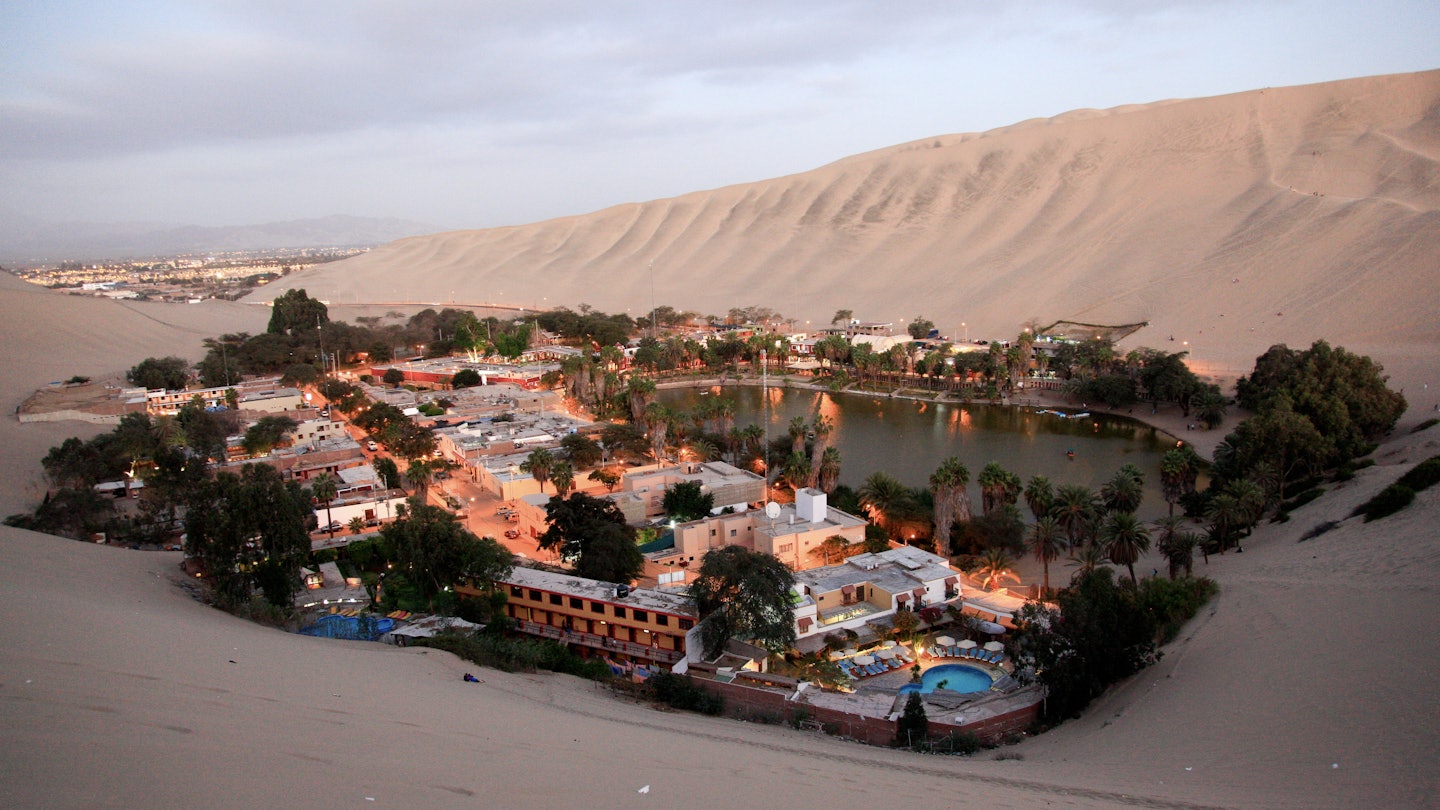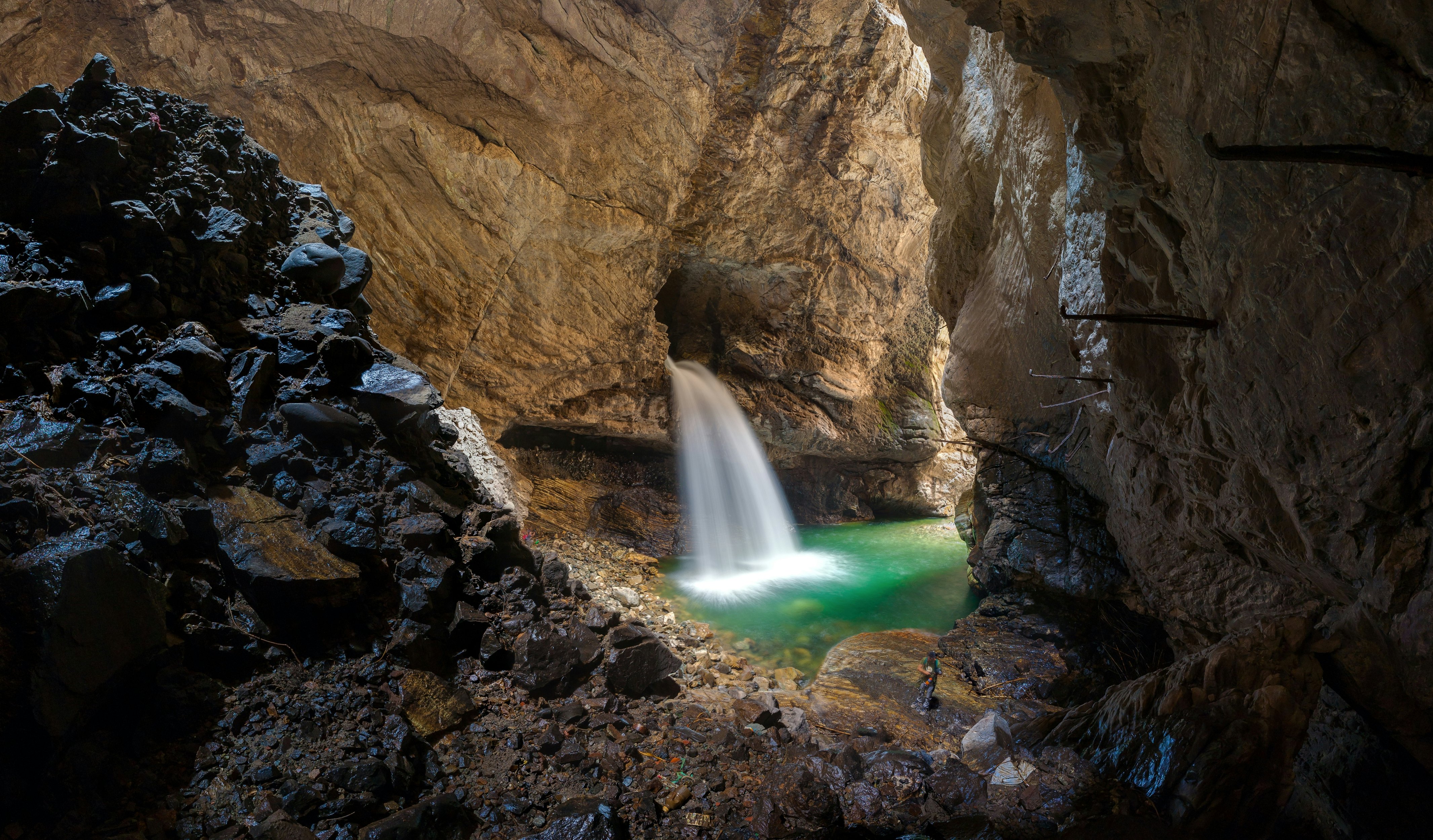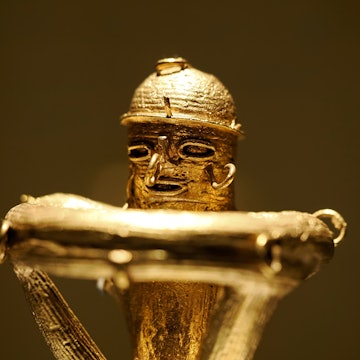

A center for adrenaline-fueled outdoor adventures, the small desert oasis of Huacachina makes a popular day trip from Lima, Peru. Shutterstock
With its top restaurants and leading museums, you might never tire of the fast-paced lifestyle and cultural riches found in Lima.
But step away from Peru’s capital city for a day and there’s plenty more to see, from roaring rapids to ancient archaeological sites. All just a few hours from the metropoliis, these are the best day trips from Lima.

1. Take a pilgrimage to Pachacamac
Travel time: 1 hour by car
A pilgrimage site for many pre-Columbian Peruvian cultures, Pachacama is a large ruin that dates back to 200 CE. Spread across the coastal desert of the Lurin Valley, the archaeological site takes its name from the creator god Pacha Kamaq.
Long before its rediscovery at the end of the 19th century, the site suffered from destruction and looting.
Yet archaeologists have continued to find secrets of the past hidden among its temples, plazas and pyramids. A guided tour will allow you to understand the evolution and transformation of this historical site.
How to get to Pachacamac from Lima:
The trip will take you just over an hour by car. Head down the Panamericana Sur, taking the exit at Lurin. On the Antigua Panamericana Sur, look for signs pointing toward the archaeological site.
2. Explore family-friendly Chancay
Travel time: 90 minutes by car
Some 75km (47 miles) north of Lima is Chancay, the heart of a pre-Hispanic civilization (roughly 1000–1500 CE) of the same name. Today, this charming coastal town continues to host a kind of kingdom – or at least a castle: the daughter of a national viceroy constructed cliffside Castillo de Chancay in the 1920s.
Renovations over the past few decades have left the medieval-style pile a tad kitschy – but the onsite museum houses some fascinating Chancay relics. The large public pool overlooking the ocean is a fun addition for families, too.
If you have time, head 20 minutes north to Lomas de Lachay, where walking trails lead you away from the traffic and amongst the local wildlife.
How to get to Chancay from Lima:
By private car take the Panamericana Norte to Chancay (just under 80km / 50 miles north of Lima); it’ll take about 90 minutes. From the Plaza Norte bus terminal in Lima, catch a bus heading to Huacho, as it will pass through Chancay.

3. Get sporty in Santa Eulalia
Travel time: 2 hours by car
Located in the district of Huarochirí, Santa Eulalia is a picturesque valley that’s ideal for connecting with nature. But don’t let the rolling hills and tranquil creeks fool you: Santa Eulalia is an adventure-sports hotspot.
The surrounding mountains and cliffs are ideal for thrill seekers interested in mountain biking, rock climbing and even bungee jumping.
Meanwhile, extensive trails for all levels can take you to lookout points over the Santa Eulalia River (keep an eye out for soaring Andean condors), toward archaeological sites, and to the foot of the Autisha waterfall.
How to get to Santa Eulalia from Lima:
This trip takes about two hours by car. Head towards Chosica by way of the Carretera Central (Central Highway). At 38km, a left turn will bring you to the town’s main plaza in a matter of minutes. For public transportation, take a taxi to Ovalo Santa Anita to find a bus heading towards Chosica. Get off at Parque Echenique and take another taxi or moto-taxi to Santa Eulalia.

4. Explore the misty Lomas de Lucumo
Travel time: 70 minutes by car
Only 34km (21 miles) from the capital, the vast Lomas de Lucumo (Hills of Lucumo) are a far cry from Lima’s manicured parks. The ocean mist gets trapped within the soft hills here, enriching the landscape with verdant green vegetation during the typically gray winter months (June–October).
Depending on your pace and route, a trek through the undulating sea of green can last anywhere from 30 minutes to three hours.
At the base of the Lomas, you can hire a knowledgable guide to point out the caves and wildlife that dot the area. If you want to go it alone, simply pass the grazing cows and begin your ascent.
How to get to Lomas de Lucumo from Lima:
It's a 70-minute drive by private car to Lomas de Lucumo. Head south on Panamericana Sur, taking the exit to Lurin, and then continue toward the Pachacamac village. Keep an eye out for the Quebrada Verde bridge, where signs will lead you to the site. If taking a taxi, ask the driver to wait for you, as it’s difficult to find a ride back.

5. Visit the archaeological wonders of Caral
Travel time: 3 hours by car
Built at the time of the Egyptian pyramids, the massive Norte Chico civilization settlement of Caral, 186km (115.5 miles) from Lima, predates the Incas by some 4000 years.
Tours of the once-thriving metropolis cover its plazas, temples, residential areas and amphitheater, all of which were ”lost” beneath the desert dunes until archaeologist Paul Kosok came across the city in 1948.
Excavations continue at the site once nicknamed the “Cradle of Civilization” – which have uncovered plenty of musical instruments but as yet no signs of war.
Despite its significance and intriguing nature, few visit Caral, likely due to its remote location. Yet the archaeological site, inscribed on UNESCO World Heritage’s list since 2009, is well worth hitting the road at sunrise for.
How to get to Caral from Lima:
It can take about three hours to get here. Catch an early ride with a bus agency that offers direct transportation, such as Movil Bus. By taxi or private car simply follow the Panamericana Norte for 184km (114 miles) until you reach the town of Supe, from which Caral is a mere 3km (2 miles) away.

6. Get high in Marcahuasi
Travel time: 3–4 hours by car
A high Andean plateau 80km (50 miles) east of Lima, Marcahuasi features dozens of ancient rock sculptures that depict anthropomorphic and zoomorphic figures – a sort of mystical stone forest. Only discovered in the mid-20th century, the site is still in the early stages of excavation.
Most travelers visit for the challenging 4km (2.5-mile) trail that takes up to three hours to complete. The expansive views from the top reach out across mountain peaks and the Colchón de Nubes (Mattress of Clouds), which hovers at eye level. Pack a warm jacket and prepare for a change in altitude with coca leaves.
If you have an extra day, the plateau’s Amphitheater campsite is ideal for stargazing.
How to get to Marcahuasi from Lima:
If you’re going just for the day, take a taxi or rent a car as the ascending roads can take three to four hours to tackle. Head east to Chosica, then onto dirt roads to San Pedro de Casta, where the trailhead is located.
7. Retreat to the Cieneguilla countryside
Travel time: 90 minutes by car or bus
Barricaded by barren desert hills, Cieneguilla is a peaceful countryside resort that’s a favorite with Limeños. The restaurants here serve up barbecued or roasted meats and sticky-sweet picarones (a traditional pastry) local to the area.
As well as inclusive green areas (soccer fields, playgrounds), outdoor seating and pools, Cieneguilla is great for picnicking and sunbathing.
If you have time, check out the Huaycan de Cieneguilla, an ancient administrative center connected to the Qhapaq Ñan trail.
How to get to Cieneguilla from Lima:
Buses direct to Cieneguilla leave from Avenida Javier Prado. It’s 90 minutes by car (or taxi): head down Javier Prado toward the Ate district, then turn onto Golf los Incas at the Ovalo Monitor. Continue onto Avenida La Molina until you can turn right onto Nuevo Toledo.

8. Get an adrenaline rush in Huacachina
Travel time: 4 hours by bus or car
Near the city of Ica, where many of Peru’s best piscos are distilled, large sand dunes act as a barrier to a desert lagoon and serve as a jumping-off point to adventure sports like sandboarding and dune-buggy riding.
It’s not uncommon to see more tourists than locals in the tiny oasis village of Huacachina, one of Peru’s most unique destinations. Here, restaurants and hostels stand in the shadows of the palm trees that line the oasis’ green waters.
Take the earliest bus ride you can find and head southwest of Peru’s capital city for a full day of pure adrenaline and desert sun. If you want to make the most out of your trip, indulge in a tasting at a local vineyard in Ica or visit the Ballestas Islands in Paracas (an additional hour by car).
How to get to Huacachina from Lima:
One of the easiest and most direct services is PeruHop, which can take you from Lima to the entrance of Huacachina. It’s about four hours by bus or car.

9. Sail away to Callao and La Punta
Travel time: 45 minutes by car, 1 hour by bus
The only reason to go to Callao, the old joke went, was to get to Jorge Chavez International Airport. Yet Lima’s seaside neighbor is slowly gaining the attention it deserves.
After perusing the art galleries and murals at Monumental Callao, cross the street to the city’s port. From here you can visit the Naval Museum, Peru’s most comprehensive military museum, or catch a boat to Las Palominas Islands, where you can swim with sea lions. They’re a great alternative to farther-afield Ballestas Islands in Paracas.
How to get to Callao and La Punta from Lima:
Just 10km (6 miles) from Lima, Callao is easily reached by a 45-minute taxi ride. Buses go from Avenida Javier Prado. For La Punta, take a bus from Javier Prado and ask if it goes to “todo La Marina.” Alight at Real Plaza San Miguel, then catch another Callao/La Punta bus to Fortaleza Real Felipe, a few blocks from Callao docks. The buses take an hour.
















